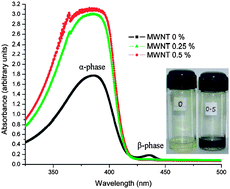Change in conformation of polymerPFO on addition of multiwall carbon nanotubes
Abstract
Multiwall

- This article is part of the themed collection: Doped nanostructures
* Corresponding authors
a
Department of Physics, School of Applied Sciences, Netaji Subhas Institute of Technology, Sector-3, Dwarka, New Delhi, India
E-mail:
maltibansal@gmail.com
b Centre for Organic Electronics, National Physical Laboratory (Council of Scientific and Industrial Research), Dr K. S. Krishnan Road, New Delhi, India
c Carbon Technology Unit, National Physical Laboratory (Council of Scientific and Industrial Research), Dr K. S. Krishnan Road, New Delhi, India
Multiwall

 Please wait while we load your content...
Something went wrong. Try again?
Please wait while we load your content...
Something went wrong. Try again?
M. Bansal, R. Srivastava, C. Lal, M. N. Kamalasanan and L. S. Tanwar, Nanoscale, 2010, 2, 1171 DOI: 10.1039/C0NR00001A
To request permission to reproduce material from this article, please go to the Copyright Clearance Center request page.
If you are an author contributing to an RSC publication, you do not need to request permission provided correct acknowledgement is given.
If you are the author of this article, you do not need to request permission to reproduce figures and diagrams provided correct acknowledgement is given. If you want to reproduce the whole article in a third-party publication (excluding your thesis/dissertation for which permission is not required) please go to the Copyright Clearance Center request page.
Read more about how to correctly acknowledge RSC content.
 Fetching data from CrossRef.
Fetching data from CrossRef.
This may take some time to load.
Loading related content
